Hans Lebkommer, "Fechtbüch / die Ritterliche / Manniche Kunst
und Handarbeyt Fechtens / und Kempf-fens. Aub warem ursprunglichem
grund der Alten / Mit sampt heymlichen Geschwindigkeyten / In leibs no-
ten sich des Feindes trostlich zuerwehren, unnd Ritterlich obzusigen etc.
Klarlich beschrie-ben unnd furgemalt.", 1558
Notes on Hans Lebkommer's Fechtbüch

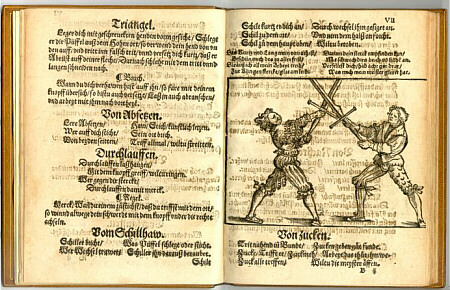 Note: AEMMA has received permission to publish the manuscript online on the AEMMA's online library by the UB München. The images are available for internal academic research purposes only and remain the property of UB München. Any desire to publish this material elsewhere or for profit must be pre-approved by UB München. However, the manuscript is available on the CD in digitized form. Click on the image for more information on ordering the Corble Collection CD. The colour images are courtesy of K.U.Leuven, Universiteitsbibliotheek.
Note: AEMMA has received permission to publish the manuscript online on the AEMMA's online library by the UB München. The images are available for internal academic research purposes only and remain the property of UB München. Any desire to publish this material elsewhere or for profit must be pre-approved by UB München. However, the manuscript is available on the CD in digitized form. Click on the image for more information on ordering the Corble Collection CD. The colour images are courtesy of K.U.Leuven, Universiteitsbibliotheek.
Backgrounder:
Hans Lebkommer's fechtbüch is a woodcut and was published in Frankfurt in 1558 by Egenolff. The fechtbüch contains 48 pages of beautifully illustrated techniques that include the great sword,  backsword/messer, dagger, unarmed techniques and quarter-staff. It is also observed that Lebkommer is not explicitly featured in the publication and therefore, bibliographically speaking, the authorship of Lecküchner may be minimal and should appear only in brackets when referencing this fechtbüch. Egenolff, originally from Strasbourg, was a publisher/printer in Frankfurt with no creditable link to any martial arts practice. The only dated edition of this book was published after his death by his heirs ("Erben")... so the dating of the previous edition to 1531 is only an assumption based on Egenolff's first appearance in the Frankfurt's trades archives.
backsword/messer, dagger, unarmed techniques and quarter-staff. It is also observed that Lebkommer is not explicitly featured in the publication and therefore, bibliographically speaking, the authorship of Lecküchner may be minimal and should appear only in brackets when referencing this fechtbüch. Egenolff, originally from Strasbourg, was a publisher/printer in Frankfurt with no creditable link to any martial arts practice. The only dated edition of this book was published after his death by his heirs ("Erben")... so the dating of the previous edition to 1531 is only an assumption based on Egenolff's first appearance in the Frankfurt's trades archives.
Click on the griffen shield to view some English translations work in progress.
Notice: Click here for details on registering with AEMMA and obtaining your Online Library electronic card.
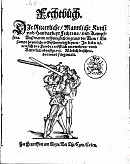 |
Section #1: Unarmoured Longsword
Here, the fechtbüch focuses on the various techniques involving the longsword. The longsword is more of the 2-hander zweihanders, as is evident with the lugs on the blade near the guard. A translation of Lecküchner's shortened sword or kurtzen Schwerdt on pages 24 verso though 25 recto of his fechtbüch can be found by clicking here. Shortened sword is how the treatises name the fighting style sometimes referred to as half-sword. The shortened sword sections contain only the instructional text, not the verses, have been translated on the above site. The verses were left out as too obtuse for use. The shortened sword section is a semi-attached addendum to the longsword section, coming after the "Beschludes langen Schwerdts" or Closing of the Long Sword. To view page 24, click here.
|
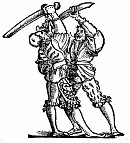 |
Section #2: Von Messer Fechten
Messer or backsword technqiues. This section begins with a discussion on the principles of vor and nach.  It is recommended that the fighter take the vor whenever possible. The chapter continues with a description of the 6 guards: Der Zornhaw (The Wrath Strike), Entwecker Awakener (Rouser), Entrüsthaw, (Shock Strike), Der Zwinger (The Restrainer), Der Geferhaw (The Threat strike) and finally, Der Wincker (The Waver). See more details on the English translation on the Messer by clicking on the shield. It is recommended that the fighter take the vor whenever possible. The chapter continues with a description of the 6 guards: Der Zornhaw (The Wrath Strike), Entwecker Awakener (Rouser), Entrüsthaw, (Shock Strike), Der Zwinger (The Restrainer), Der Geferhaw (The Threat strike) and finally, Der Wincker (The Waver). See more details on the English translation on the Messer by clicking on the shield. |
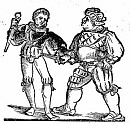 |
Section #3: Fechten im Dolchen
Dagger techniques. |
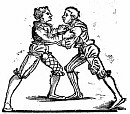 |
Section #4: Ringen
Wrestling techniques. |
 |
Section #5: Fechten inn der Gtangen
This section describes what appears to be 1/2-staff or 1/4-staff techniques. |

 Note: AEMMA has received permission to publish the manuscript online on the AEMMA's online library by the UB München. The images are available for internal academic research purposes only and remain the property of UB München. Any desire to publish this material elsewhere or for profit must be pre-approved by UB München. However, the manuscript is available on the CD in digitized form. Click on the image for more information on ordering the Corble Collection CD. The colour images are courtesy of K.U.Leuven, Universiteitsbibliotheek.
Note: AEMMA has received permission to publish the manuscript online on the AEMMA's online library by the UB München. The images are available for internal academic research purposes only and remain the property of UB München. Any desire to publish this material elsewhere or for profit must be pre-approved by UB München. However, the manuscript is available on the CD in digitized form. Click on the image for more information on ordering the Corble Collection CD. The colour images are courtesy of K.U.Leuven, Universiteitsbibliotheek.




